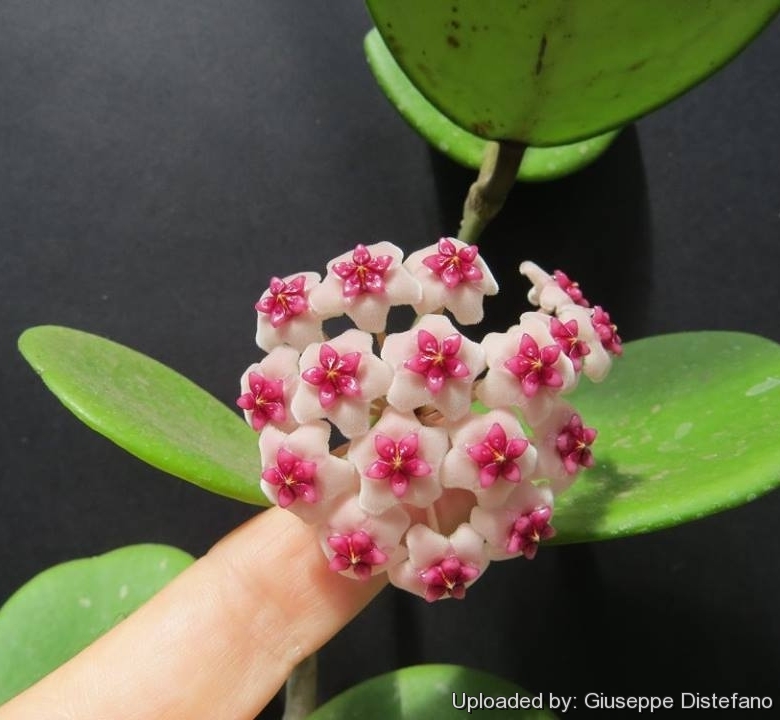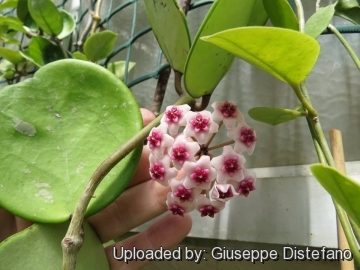




Your support is critical to our success.

Origin and Habitat: Hoya obovataSN|23711]]SN|26400]] occours in India, Indonesia, Thailand and Fiji.
Type locality: This hoya was described in 1844 from Indonesia (Sulawesi).
Habitat and ecology: It is a creeping epiphyte growing in open places and along forest edges often in masses closely covering the trunk and limbs of the host trees. In habit and mode of growth this species reminds one of the Hoya bellaSN|26400]]SN|23711]].
Synonyms:
- Hoya obovata Decne.
FINNISH (Suomi): Ruusuposliinikukka
RUSSIAN (Русский): Хойя обратнояйцевидная
Description: Hoya obovataSN|26309]]SN|26400]] is a robust climbing plant, also known as the sweetheart or heart-leaf hoya, due to the large glossy leaves that are almost round or shaped like 'inverted' hearts, notched at the tips into 2 distinct lobes, very thick and leathery. The size of the leaves can be anything from about 6 to 15 cm in diameter and, 8 to 10 cm broad. Flowers to 15 mm across, comes in semi-pendent, flattened umbels, of 15 to 25 hanging from along the stems, the corolla is creamy white, yellowish orange or pinkish yellow, the corona is purplish red, dark orange brownish in the centre. There is also a variegated variety of this hoya that has absolutely gorgeous dark green leaves with lots of silver flecks. The variegation is pink when the leaves are young and the variegation on this hoya also seems stable. The leaf size is about the same as for the "green" one.
Stems: Branches thick, twining, green.
Leaves: Thick, fleshy, leathery, glabrous, obovate to obcordate up to 15 cm long, 8-10 cm wide, very thickly tip 2-lobeded, base attenuate, margin revolute
Inflorescences (Umbels): Flat, 15 cm in diameter with 20-25 flowers; peduncle shorter than petioles.
Flowers: Calyx small. Corolla rotate, fleshy, deeply 5-lobed, 1.5 cm in diameter, cream-coloured to light pink, glabrous, inside densely papillose. Corona of 5 fleshy lobes spreading, star-like. Lobes broadly ovate, depressed in the middle, 4 mm long, apically revolute purple-red, darker at centre, outer corona lobes outer appendage round, inner appendage acute. The flowers produce some nectar drops and the fragrance is like roses, but more on the sweet side.
Blooming season: It blooms continuously from late spring into fall. The blossom is long lived and each umbel lasts almost two weeks.
Fruits (follicles): Glabrous.
Similar: Hoya obovata superficially resemble Hoya kerriiSN|26400]]SN|26309]], but has an overall larger flower with a larger corona as well as a slightly different leaf shape and the general absence of any pubescence.
Bibliography: Major references and further lectures
1) Focke Albers, Ulrich Meve “Illustrated Handbook of Succulent Plants: Asclepiadaceae: Asclepiadaceae”, Volume 4 Springer Science & Business Media, 2002
2) Friedrich Anton Wilhelm Miquel “Flora van Nederlandsch Indië”, Volume 2, Edition 2 Van der Post, 1856
3) “The Plantsman”, Volumi 10-11, page 138, New Perspectives Pub., 1988

Hoya obovata Photo by: Giuseppe Distefano

Hoya obovata Photo by: Giuseppe Distefano
Cultivation and Propagation: Hoya obovata is a fast growing hoya that flowers willingly and relatively early. Sometimes already as a cutting. It isn't difficult to grow and flower and is one of the strongest growing Hoyas. There are a few Hoya's which make ideal houseplants, Hoya obovata or the Sweetheart Plant is one of them. This is an attractive thick leafed species is well suited for baskets or ladders, the thick large round leaves up to 10 cm across make this an attractive sought after species even without flowers. Ot is hardy but requires protection in very cold climates.
Growth rate: This is a Hoya that needs a lot of space, but it grows relatively slowly so this is normally not a problem. The all green variety tends to grow more quickly (although it's still slow by most houseplant standards) and is arguably more hardy, but it also comes in a pretty slow growing variegated variety.
Potting medium: Because it is an epiphyte, the sweet heart hoya benefits from being potted
up in a very well-draining and porous growing medium. Often specialized hoya growers either use only chopped coconut husk or a good orchid potting mixture for growing their hoya plants. The medium needs to be moisture-retentive.
Watering: Water regularly during the growing season,
Watering: With its succulent qualities it's quite adapt at storing water for longish periods of time between waterings. Water regularly in summer, but do not overwater ( wet-sensitively) and let the plants to dry out between watering and then water again. Its roots are easily lost in pots that stay damp for any length of time. Keep quite dry with ample airflow in winter (It would probably tolerate one watering a month). In the rest period no high atmospheric humidity. Care must be taken with watering as they tends to become swollen and untidy in growth habit if given too much water and shade.
Fertilization: During the growing season enrich the soil using a fertilizer rich in potassium and phosphorous, but poor in nitrogen, because this chemical element doesn’t help the development of succulent plants, making them too soft and full of water.
Exposition: Outside half shade to shade (filtered sunlight or afternoon shade tolerated) , inside it will need a reasonably light room in order to actually grow, although it will still get by even in a shadier spot and can be positioned almost anywhere in homes or offices. It subject to sunburn if exposed to direct sun for too long. Tends to bronze in strong light, which encourages flowering and heavy leaves production.
Spring: When winter ends and they begin to grow again, they will require much water and soaking the pots will no longer put the plants at risk for rot. In the spring they will grow well in partial shade and leaving them out in the rain may provide them with the water they need.
Summer: In the summer months they will tolerate heavy rain, but will be just as happy if the season is dry. They will tolerate hot weather outdoors as long as they are kept in strongly filtered light and this will encourage them to flower. They also enjoy some fertiliser. Moving the plants as they are developing buds may cause them to spontaneously abort the flowers all together.
Autumn: In the fall keep them outdoors until the night time temperatures drop below the 10°C.
Winter: Winter care presents no problems at 10° C with plenty of light. In winter be sure to take extra precautions to keep them dry, because damp cool conditions when the plants are resting is an invitation to fungal infections, but - according to temperatures –some occasional lit watering may be useful.
Pest and diseases: Hoya are generally fairly easy to grow, especially if kept pest-free. They are very susceptible to stem and root mealy bugs, and damage from these may well initiate fungal attack. Any time when there is a dead or dying stem in the pot it is important to remove it immediately and completely before other healthy stems can become ill too, isolate the healthy parts, dry them off, and re-root them in new compost.
Propagation: Easiest with leaf and stem cuttings. Above says propagation by leaf cuttings. Leaf cuttings will root, but will not grow any larger. You must have some stem attached to the leaf cuttings to get a growing plant. The stems produce aerial roots which roots root easily when inserted into a moist medium making it easy to propagate new plants from stem cuttings. Allow cuttings to dry a day before planting. It can also be increased from seeds sowing in spring in moist, sandy peat moss. Barely cover seeds. Seeds germinate quickly.
Repotting: In any season it's best to lay the stems out for several days before replanting them and then pot them only in dry soil and withhold any water until they begin to shrivel or start growing again. Re-pot every 2 years.
| Your Actions | |
|---|---|
| Back to Hoya index | |
| Back to Asclepiadaceae index | |
 |
Back to Succulents Encyclopedia index |
Privacy stantement - Terms and conditions - How to cite - About us - Feedback - Donate



